|
Temperance Hall / Jowett Hall / Civic Playhouse / Film Theatre / Priestley Centre for the Arts / Playhouse Chapel Street, Little Gemany, Bradford.
Quick links to other sections on this page . . .
Location Temperance Hall Capable of accommodating circa 660 people it fist showed experimental films using a 'fit up' projector and sheet (screen) from 1900. In January 1908 Sidney Prince promoted films on a regular basis trading as 'Sidney Prince's Pictures' and this lasted about two years. Following the 1909 Cinematograph Act, the hall closed for alterations to meet safety requirements and re-opened as a permanent cinema on Wednesday 22nd September 1909 and advertised . . . "The finest picture hall in the North.After a short closure it was re-opened again on Tuesday 8th February 1910 by Henry Hibbert with an early talkie film . . . "A Trip Through Jersey" to demonstrateHenry Hibbert was already well known in the city for his "Saturday Evening Entertainments" and "Cinematograph Exhibitions" at the Mechanics Institute in 1904. Hibbert, now trading as Hibbert's Pictures, was already expanding his cinema interests to the Dales and other towns using the Temperance Hall as his headquarters. The cinema was registered as Bradford Picture Theatre Ltd with Mrs A. Crowther as resident manager. Prices were 4d to 8d. The Temperance Hall closed as a cinema on Saturday 25th March 1922 with the film . . . "His Friend's Wife" - 1911 USA B/w Silent.Hibbert's Pictures headquarters were then transferred to his Towers Hall cinema in Manchester Road. Jowett Hall The Playhouse was an offshoot of the Leeds Playhouse and had used the Jowett Hall for their Bradford Productions. They had just staged a play "Noé" at the Jowett Hall following which a fire had started in the hall and totally destroying the building. The Playhouse company then bought the land and commissioned local Architect Eric Morley to design a new purpose built theatre in a project costing circa £10,000. Civic Playhouse The new, and very much smaller, dual function hall was to be known as the Civic Playhouse. The architect was Eric Morley FRIBA of W.J Morley & Son FRIBA in Swan Arcade. The New Building Interior The flat-fronted balcony with a small open loges at each end leading to entrance/exit doors and with 8 rows of seats and the stalls also of 8 rows in stadium plan make this an intimate style of theatre/cinema. The projection room was at the rear of the stalls and equipped with two GB Kalee projectors and Kalee sound system. The screen was fixed to the back wall of the stage. In this new building there was no flytower but ample dressing rooms, storage and wardrobe space were available under the stage and stalls at foyer level. A crossover corridor was under the stage front. The Opening The World Premier of James Gregson's production of The following month the first film opened on Monday 8th February 1937 with . . . "Whom the Gods Love" - (details unknown)The proprietors were registered as Civic Playhouse Friendly Society. Films were shown every third week alternating with stage productions. Film programmes were usually non-mainstream, arty or foreign language offerings playing to a discerning clientele. By 1949 the cinema prices were 1/6d to 2/3d dearer than the city centre main circuit cinemas. The distinguished theatre history of the Civic Playhouse is not recorded here - only its rôle in the history of cinemas in Bradford. 21st Anniversary "When We Are Married"The cast and audience sang 'Happy Birthday' for the theatre and for the Lord Mayor for it was his birthday too. Also present was Eric Morley FRIBA architect of the Civic Playhouse. A Second Screen However, a second screen was constructed in the rear of the basement where the café had previously been. It was a very small affair seating only around 35 and with a small screen and 16mm projection equipment. For a period of time films were booked in conjunction with the British Film Institute and Bradford's National Museum of Photography, Film and Television (now the National Media Museum). In 1992 some £48,000 was spent in renovations to bring the cinema up to standard. Luxury Screen Two The plan was to transform it into a luxury 75 seat cinema with . . . A grand plan which did not happen and fizzled out. By coincidence, the 3-screen Odeon Film Centre was considering plans to further sub-divide to make 7 screens but this too did not materialise. Fire, Rebuild and New Name The stage was completely rebuilt and a much needed flytower added and the theatre was renamed Priestley Centre for the Arts. The proscenium arch theatre stage now had an apron projection over a pit with original crossover beneath. The new stage had a cyclorama rear wall, rear manual curtains, electrically operated mid-stage tabs which double as screen side masking. The 22 feet wide cinema screen is of the electric roll-up type. The main house tabs can be both drawn or flown upwards. A safety curtain is fitted. New lighting is computer controlled from the 'tech box' within the projection room as is the comprehensive sound system. The projection room contains a single 35mm projector, platter and Dolby surround sound plus 16mm and video facilities. 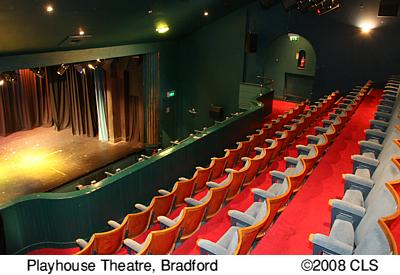
Seating is now 291 with 8 rows in both stalls and balcony in a single centre block stadium style with side aisles. The projection system has been 'mothballed' for some time but in 2008 was overhauled and films can be shown again. Studio Theatre Currently (2008) the basement has been refurbished and opened up as a bar and servery, meeting place, small performance space and gallery for local artists. Haunted Theatre J.B Priestley himself is said to haunt the place by walking across the foyer only to disappear into the stairs. Around 1980 there was the ghostly interruption on the sound system shouting "Breaker One Nine for a copy" but perhaps that one has been driven away. Paranormal investigator teams have checked out the building which they claim is a very active paranormal site. Not surprisingly the theatre organises Ghost Nights at a cost for you to experience it yourself. Renamed Playhouse again In 2009 the Playhouse secured a grant of £51,000 to fund a three-year business plan with a view to coming out of administration. More film showings are promised and in March 2010 the Playhouse has a programme of films as a 'satellite' screen of the 16th Bradford International Film Festival. For the time being, cinema still continues on this 110 year-old and chequered historic site. May not be copied or reproduced without permission.
|
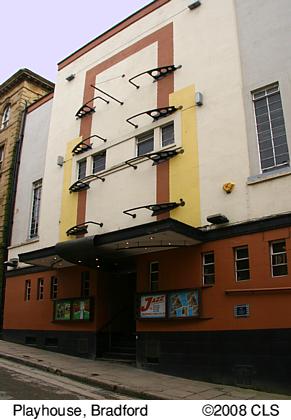
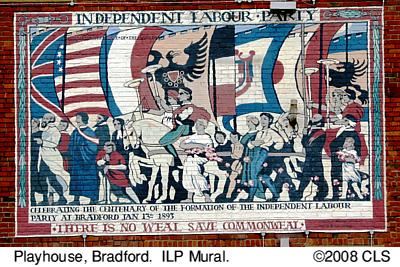 The former Temperance Hall later re-opened as the Jowett Hall named after Fred Jowett who became a Minister in the 1924 Labour Government and very active in the Bradford Independent Labour Party (ILP). The Jowett Hall was destroyed in a fire on Monday 25th March 1935.
The former Temperance Hall later re-opened as the Jowett Hall named after Fred Jowett who became a Minister in the 1924 Labour Government and very active in the Bradford Independent Labour Party (ILP). The Jowett Hall was destroyed in a fire on Monday 25th March 1935.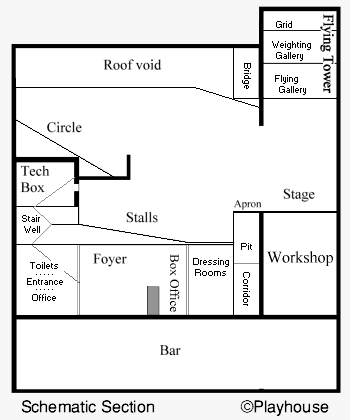 A major fire broke out just after 11.00pm on Friday 19th July 1996 causing "hundreds of thousands of Pounds worth of damage" which almost totally destroyed the stage and roof. Luckily it was discovered in time to prevent it spreading to the auditorium as the safety curtain had been lowered. Earlier in the same week there had been a small fire in the projection room. The cause of both fires remains unknown.
A major fire broke out just after 11.00pm on Friday 19th July 1996 causing "hundreds of thousands of Pounds worth of damage" which almost totally destroyed the stage and roof. Luckily it was discovered in time to prevent it spreading to the auditorium as the safety curtain had been lowered. Earlier in the same week there had been a small fire in the projection room. The cause of both fires remains unknown.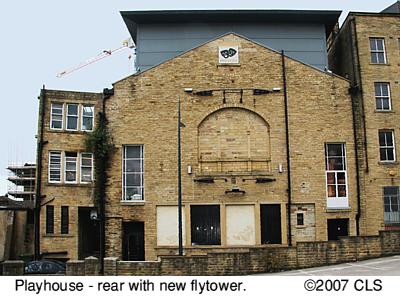 A fairly recent discovery seems to be its ghosts. It is claimed the ghost sits in chair H18 in the rear of the stalls. Other ghosts include Amelia, a little girl who fell from the balcony and whose giggling is heard by technicians over their headphones when setting up equipment.
A fairly recent discovery seems to be its ghosts. It is claimed the ghost sits in chair H18 in the rear of the stalls. Other ghosts include Amelia, a little girl who fell from the balcony and whose giggling is heard by technicians over their headphones when setting up equipment.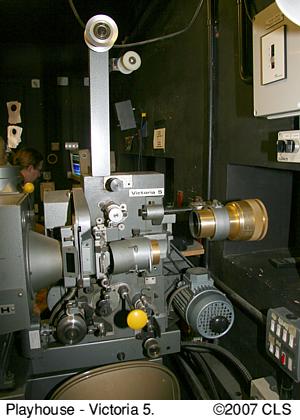 After the latest of several financial problems and being in administration, the former Priestley now has a new management team and its organisation restructured and re-invented itself as the Playhouse - the name by which older people always knew it.
After the latest of several financial problems and being in administration, the former Priestley now has a new management team and its organisation restructured and re-invented itself as the Playhouse - the name by which older people always knew it.